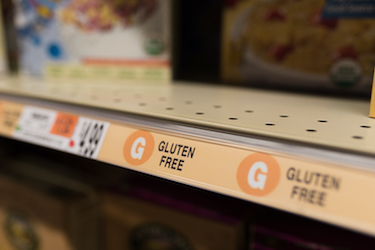
Project Summary
Please note: This is an archived project that is not currently being updated.
In the ever-expanding search for what ails us, many people believe that allergies to foods or environmental compounds are contributing to their health problems. Food allergies are a complicated topic, though. Food allergy, food sensitivity, and food intolerance are not the same and not all allergy tests measure the same reaction. The consumer needs to understand different allergy testing procedures for the best outcome. While the information on this page hasn’t been updated recently, it provides a good overview of the food allergy testing process as an educational resource.
Project Topics
Food Allergy Testing: Buyers Beware!
Allergies to common substances are a frequent topic of popular media, and one only has to look down the aisles at the grocery store to see the impact. Entire product lines now focus on foods free of items that may be related to negative reactions in certain people (e.g. gluten, peanuts, tree nuts, eggs, soy). Allergy testing has become big business in the healthcare industry. A plethora of blood tests are now available that don’t even require a doctor visit. Allergy test panels are available at grocery stores, and the consumer can get a home test kit for diagnosis. Blood tests can cost as much as $200-1000 each. The medical landscape regarding allergy testing is not only complicated from a scientific and policy viewpoint, but physicians may not have the most recent information. Have scientific advancements led to wonderful new tests to assist in the diagnosis of allergies or has the commercialization of allergy tests — and the resulting increase in people diagnosed with various allergies — come at a cost to our health?

Definitions
Some definitions are required to even begin a discussion about food allergies.
- Food allergies are defined as an adverse immune response to proteins in food. Allergies result because the body produces antibodies to something recognized as an antigen (peanut proteins, for example), and this is usually measured through an immunoglobulin E (IgE) response.
- Food allergies are different from food intolerance, such as lactose intolerance, which is not an immune-mediated response.
- Food sensitivity is a nonspecific medical term that is used in a variety of ways. Immunoglobulin G (IgG) is often measured as an indicator of food sensitivity.
Food Allergy Tests
Skin tests, blood tests, food challenges — there are a number of allergy tests out there and not all tests are designed to measure the same thing. Before considering allergy testing, be sure to become familiar with the methods, pros, and cons of each test by reading our Food Allergy Tests explained.
Recommendations from the Experts
So, what is a person to do regarding allergy testing? The experts indicate that the best method for diagnosing an allergy is to begin with a thorough medical history after which an allergist may order a skin prick test based on the results. Serum IgE tests may also be used to evaluate the response to specific foods, but not normally to a whole panel of randomly chosen foods. The gold standard continues to be an oral food challenge — a double blind placebo controlled test conducted in the doctor’s office so that treatment for possible anaphylaxis can be provided. See Additional Resources below for links to statements by the national allergy associations of the U.S., Canada, and Europe against the use of IgG blood testing to diagnose food allergies.
Additional Resources
Allergy Association Statements Regarding Food Allergy Testing
- Guidelines for the Diagnosis and Management of Food Allergy in the United States: Summary of the NIAID Sponsored Expert Panel Report. Boyce et al. J. Allergy Clin Immunol, December 2010.
- CSACI Position statement on the testing of food-specific IgG. Stuart Carr, Edmond Chan, Elana Lavine and William Moote Carr et al. Allergy, Asthma & Clinical Immunology 2012, 8:12.
- Testing for IgG4 against foods is not recommended as a diagnostic tool: EAACI Task Force Report. Stapel SO, Asero R, Ballmer-Weber BK, Knol EF, Strobel S, Vieths S, Kleine-Tebbe J; EAACI Task Force. Allergy. 2008 Jul;63(7):793-6.
Food Allergy Testing Review Articles
- Gerez, I.F.A., Shek, L.P.C., Chng, H.H., Lee, B.W. Diagnostic tests for food allergy. Singapore Med 2010; 51(1) :4. Free full text.
- Lock RJ, Unsworth DJ. Food allergy: which tests are worth doing and which are not? J. Clin Exp Allergy. 2010 Oct;40(10):1442-60. Abstract
- Mullin,G.E., Swift,K.M., Lipski, L., Turnbull,L.K., Rampertab, S.D. Testing for Food Reactions: The Good, the Bad, and the Ugly Nutrition in Clinical Practice, Vol. 25(2) 2 April 2010 192-198. Abstract
- Siles. R.I., Hsieh, F.H. Allergy blood testing: A practical guide for clinicians. Cleveland Clinic Journal of Medicine, Vo. 78(9), Sept. 2011. Free full text
News Articles
- Here is an article in the LA Times from July 20, 2009 that discusses the topic of food allergies.
- The Wall Street Journal published this article on Jan. 26, 2010 highlighting the concern about erroneous allergy tests and the impact on children’s health.
- This article covers facts and fallacies about food allergies and was published in the Jan. 10, 2011 edition of the NY Times.
- This March 20, 2012 article from NPR covers the topic of various food allergy tests.
- The Journal of the American Medical Association announced the publication of an article (not available online) of a study by the American Academy of Allergy, Asthma & Immunology in their June, 2014 issue. The JAMA column supports evidence-based evaluation of food allergies to avoid misdiagnosis and inappropriate management.
- Last updated on August 2, 2023
Human Health News

The dangers of low-value healthcare
Overused, unnecessary, or low-value healthcare options can have significant negative effects on patients, providers, and the healthcare system. This is partly due to cascading effects

Hormonally: every woman’s ally in understanding hormonal health
Hormonally is a new nonprofit dedicated to promoting equal access to evidence-based information on women’s hormone health. The organization has announced the launch of its

Niacin and chilblains
If you have been diagnosed with chilblains, you know how painful they can be during cold weather. Niacin may provide some relief and may even

The dangers of low-value healthcare
Overused, unnecessary, or low-value healthcare options can have significant negative effects on patients, providers, and the healthcare system. This is partly due to cascading effects

Hormonally: every woman’s ally in understanding hormonal health
Hormonally is a new nonprofit dedicated to promoting equal access to evidence-based information on women’s hormone health. The organization has announced the launch of its

Niacin and chilblains
If you have been diagnosed with chilblains, you know how painful they can be during cold weather. Niacin may provide some relief and may even

COVID-19 treatments and Long COVID outcomes
As we learn more about Long COVID, its negative impacts on health and wellbeing are becoming clearer. Symptoms of Long COVID are diverse and include


